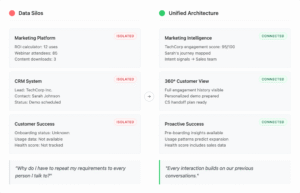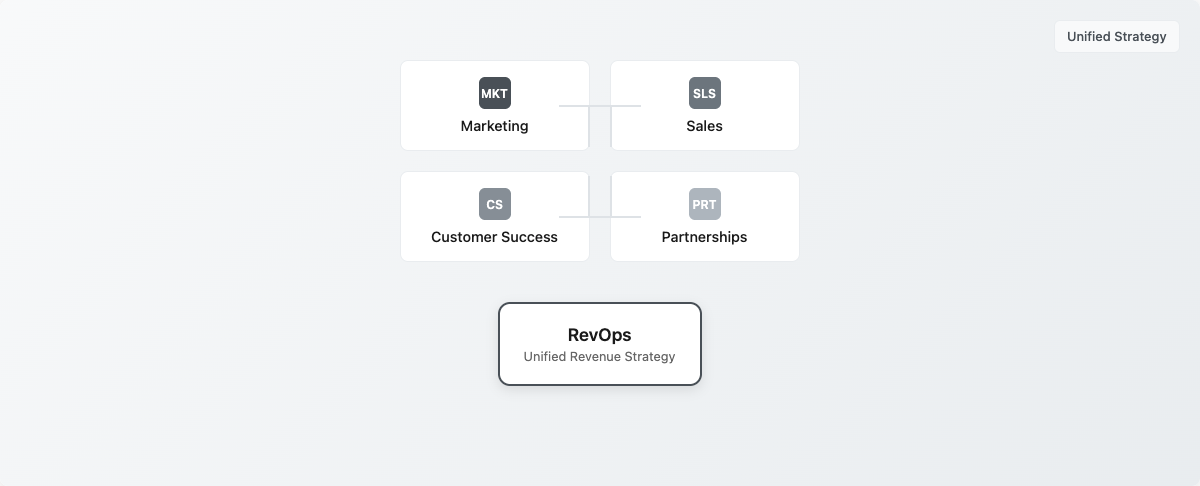How aligning your revenue-generating teams isn’t just operational efficiency—it’s competitive advantage.
There’s a moment in every SaaS executive’s journey when the growth formula that got them to $10M ARR suddenly stops working at $50M. The sales team blames marketing for poor lead quality. Marketing points to sales for low conversion rates. Customer Success struggles with churn because they don’t have visibility into the customer journey. And partnerships? They’re operating in a completely different universe.
Sound familiar?
This isn’t a people problem—it’s a systems problem. And the solution isn’t another tool or process. It’s Revenue Operations.
What Revenue Operations Actually Is (And Why Most Companies Get It Wrong)
Revenue Operations isn’t just sales operations with a fancier name. It’s not another layer of bureaucracy or a way to consolidate departments to cut costs.
Revenue Operations is the strategic discipline of aligning all revenue-generating functions around a unified view of the customer journey and shared business outcomes.
Think of it this way: if your company were a symphony orchestra, each department—Marketing, Sales, Customer Success, and Partnerships—would be a different section. Without a conductor (RevOps), you might have talented musicians, but you won’t have harmony. You’ll have noise.
The data supports this analogy. According to Aberdeen Group’s 2024 Revenue Operations research, companies with aligned revenue teams see:
- 36% higher customer retention rates
- 38% higher sales win rates
- 27% faster three-year profit growth
- 19% faster revenue growth year-over-year
Additionally, Salesforce’s State of Sales report reveals that high-performing sales organizations are 2.3x more likely to have tightly aligned sales and marketing teams, while McKinsey’s B2B research shows that companies with strong cross-functional alignment achieve 15% higher profitability.
But here’s what the statistics don’t capture: the psychological shift that happens when teams start thinking like owners of the entire customer experience rather than guardians of their departmental metrics.
The Four Pillars of Revenue Operations Excellence
1. Unified Data Architecture: Creating Your Single Source of Truth
Most SaaS companies are drowning in data but starving for insights. Your marketing automation platform shows one picture, your CRM tells a different story, your customer success tool has its own version of events, and your partnership management system exists in isolation.
The RevOps approach: Build a unified data architecture where customer information flows seamlessly between systems, creating a 360-degree view of every account.
This isn’t just about technology integration—it’s about data governance. When your Account Executive can see that a prospect downloaded three whitepapers, attended a webinar, and had their technical team evaluate your API documentation, they’re not starting a conversation cold. They’re continuing a relationship.
Practical implementation: Start with customer journey mapping across all touchpoints. Identify where data currently lives in silos, then prioritize integration based on revenue impact. The goal isn’t perfect data—it’s actionable data.
Real-world example: A Series B SaaS company I worked with discovered that prospects who engaged with their ROI calculator were 4x more likely to become customers, but this insight was trapped in their marketing analytics. By integrating this data into their CRM, sales reps could prioritize outreach and customer success could proactively engage new customers who hadn’t used the calculator, resulting in 23% faster onboarding and 31% higher first-year expansion revenue.
2. Process Standardization: The Framework for Predictable Growth
Here’s a counterintuitive truth: the most creative and innovative SaaS companies often have the most standardized revenue processes. Why? Because standardization frees up mental energy for what actually requires creativity—solving customer problems.
When your processes are standardized:
- New team members onboard faster
- Performance becomes measurable and improvable
- Handoffs between teams become seamless
- Customer experience becomes consistent
The RevOps approach: Document and optimize every step of your customer lifecycle, from first marketing touchpoint to renewal and expansion.
But here’s the nuance most companies miss: standardization doesn’t mean rigidity. It means having a strong foundation that allows for intelligent deviation when the situation calls for it.
According to HubSpot’s 2024 Sales Enablement Report, companies with documented sales processes experience 18% higher revenue growth than those without. More telling: Gartner’s research shows that B2B organizations with standardized processes across marketing, sales, and customer success achieve 32% higher win rates and 23% shorter sales cycles.
Customer Data Flow: Before vs After

3. Cross-Functional Metrics: Measuring What Matters
Traditional departmental metrics create misaligned incentives. Marketing optimizes for leads, regardless of quality. Sales focuses on closing deals, regardless of fit. Customer Success works on retention, but lacks visibility into the factors that drive churn risk during the sales process.
Revenue Operations introduces shared metrics that align all teams around customer lifetime value and revenue growth.
Consider pipeline velocity—a metric that measures how quickly opportunities move through your sales funnel. This metric requires:
- Marketing to generate qualified opportunities (not just volume)
- Sales to efficiently progress deals (not just close them)
- Customer Success to provide feedback on deal quality (reducing future churn risk)
- Partnerships to contribute opportunities that align with your ideal customer profile
When teams share metrics, they share accountability. And when they share accountability, they collaborate instead of compete.
Case study insight: A $50M ARR SaaS company implemented pipeline velocity as a shared metric across all revenue teams. Within six months, they saw their average deal size increase by 28% and sales cycle decrease by 35%—not because they changed their product, but because marketing began targeting higher-value prospects, sales focused on deals with stronger buying signals, and customer success provided early intelligence about expansion opportunities.
4. Strategic Orchestration: The Art of Revenue Leadership
This is where Revenue Operations transcends tactical execution and becomes strategic advantage. It’s about orchestrating all revenue-generating activities to create compound growth effects.
For example: Your marketing team identifies that prospects who engage with specific content types have 3x higher conversion rates. Your sales team notices these same prospects have shorter sales cycles. Your customer success team observes that customers who engaged with this content during their buyer journey have higher product adoption scores.
Without RevOps: Each team optimizes their piece in isolation.
With RevOps: You create an integrated campaign that amplifies this content across all touchpoints, accelerating the entire customer lifecycle.
This orchestrated approach creates what behavioral economist Robert Cialdini calls “commitment consistency”—when prospects engage with your insights across multiple touchpoints, they become psychologically invested in your perspective, making them more likely to buy and more likely to share your content with their network.
The Transformation: From Functional Silos to Revenue Orchestra
Implementing Revenue Operations isn’t about reorganizing your team structure overnight. It’s about evolving your operational mindset.
Phase 1: Visibility Start by giving all revenue teams visibility into each other’s activities and metrics. This alone will spark natural collaboration as teams begin to understand how their work impacts others.
Phase 2: Alignment Introduce shared objectives and cross-functional metrics. This is where the real culture shift begins—when success becomes truly interdependent.
Phase 3: Optimization With aligned teams and shared visibility, you can now optimize for total revenue efficiency rather than departmental efficiency.
Phase 4: Innovation This is where Revenue Operations becomes your competitive moat. You can experiment with new go-to-market motions, test integrated customer experience improvements, and adapt to market changes faster than competitors operating in silos.
The Leadership Imperative: Why This Starts at the Top
Revenue Operations isn’t an operations initiative—it’s a leadership philosophy. It requires executives who are willing to:
- Sacrifice departmental optimization for company optimization
- Invest in long-term systematic improvements over short-term tactical wins
- Measure success by customer outcomes, not just internal metrics
- Build cultures of collaboration, not competition
The most successful RevOps implementations I’ve observed started with a CEO who said, “We’re going to optimize for the customer experience, even if it means our departmental metrics look different.”
Your Revenue Operations Roadmap
If you’re ready to begin this transformation, start here:
Week 1-2: Conduct a revenue team alignment audit. Map your current customer journey and identify the gaps between how teams currently operate and how customers actually buy.
Week 3-4: Establish cross-functional communication rhythms. Monthly revenue reviews where all teams share insights and identify collaboration opportunities.
Month 2: Define your first shared metric. Start with something simple but meaningful—like qualified pipeline generated through integrated efforts.
Month 3: Implement your first process integration. Often, this is improving the marketing-to-sales handoff or the sales-to-customer success transition.
Quarter 2: Scale what’s working. The goal isn’t perfection—it’s progress toward better alignment and customer experience.
Implementation reality check: The most common failure point is trying to change everything at once. Companies that succeed start with one integration, prove value, then expand. Companies that fail try to implement the “perfect” RevOps system from day one.
The Compound Effect of Revenue Operations
Companies that master Revenue Operations don’t just grow faster—they grow more predictably, more efficiently, and more sustainably. They create customer experiences that competitors can’t replicate because their entire organization operates as a unified system.
More importantly, they build cultures where talented people want to work because they can see how their individual contributions impact the bigger picture.
The question isn’t whether Revenue Operations will become standard practice in SaaS—it’s whether you’ll be leading the transformation or catching up to it.
The companies defining the next decade of B2B growth aren’t just building better products—they’re building better systems to deliver, grow, and retain customers. Revenue Operations is how they’re doing it.
The most successful SaaS companies of the next decade won’t just be those with the best product-market fit—they’ll be those with the best revenue-market fit. They’ll be the ones who turn their entire organization into a customer success machine.
What’s your experience with revenue team alignment? I’d love to hear about the challenges and breakthroughs you’ve observed in your organization.

Leave a Reply